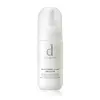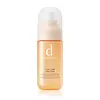What's inside
What's inside
 Key Ingredients
Key Ingredients

 Benefits
Benefits

 Ingredients Side-by-side
Ingredients Side-by-side

Water
Skin ConditioningDipropylene Glycol
HumectantButylene Glycol
HumectantGlycerin
HumectantHydrogenated Polydecene
EmollientTranexamic Acid
AstringentDimethicone
EmollientErythritol
HumectantTrehalose
HumectantXylitol
HumectantPEG/PPG-17/4 Dimethyl Ether
Skin ConditioningPEG-60 Glyceryl Isostearate
Pentaerythrityl Tetraethylhexanoate
EmollientPEG-5 Glyceryl Stearate
EmulsifyingPhenoxyethanol
PreservativeCetyl Ethylhexanoate
EmollientPetrolatum
EmollientBehenyl Alcohol
EmollientDimethylacrylamide/Sodium Acryloyldimethyltaurate Crosspolymer
Carbomer
Emulsion StabilisingBatyl Alcohol
EmollientHydrogenated Palm Oil
EmollientElaeis Guineensis Kernel Oil
EmollientDipotassium Glycyrrhizate
HumectantElaeis Guineensis Oil
EmollientSodium Metaphosphate
BufferingPotassium Hydroxide
BufferingBetaine
HumectantPhytosteryl/Octyldodecyl Lauroyl Glutamate
Skin ConditioningSodium Metabisulfite
AntioxidantSaccharomyces Ferment Lysate Filtrate
Skin ConditioningSanguisorba Officinalis Root Extract
CleansingPEG/PPG-14/7 Dimethyl Ether
Skin ConditioningSodium Hyaluronate
HumectantTocopherol
AntioxidantLamium Album Flower/Leaf/Stem Extract
Skin ConditioningCrataegus Monogyna Flower Extract
Skin ConditioningCitric Acid
BufferingWater, Dipropylene Glycol, Butylene Glycol, Glycerin, Hydrogenated Polydecene, Tranexamic Acid, Dimethicone, Erythritol, Trehalose, Xylitol, PEG/PPG-17/4 Dimethyl Ether, PEG-60 Glyceryl Isostearate, Pentaerythrityl Tetraethylhexanoate, PEG-5 Glyceryl Stearate, Phenoxyethanol, Cetyl Ethylhexanoate, Petrolatum, Behenyl Alcohol, Dimethylacrylamide/Sodium Acryloyldimethyltaurate Crosspolymer, Carbomer, Batyl Alcohol, Hydrogenated Palm Oil, Elaeis Guineensis Kernel Oil, Dipotassium Glycyrrhizate, Elaeis Guineensis Oil, Sodium Metaphosphate, Potassium Hydroxide, Betaine, Phytosteryl/Octyldodecyl Lauroyl Glutamate, Sodium Metabisulfite, Saccharomyces Ferment Lysate Filtrate, Sanguisorba Officinalis Root Extract, PEG/PPG-14/7 Dimethyl Ether, Sodium Hyaluronate, Tocopherol, Lamium Album Flower/Leaf/Stem Extract, Crataegus Monogyna Flower Extract, Citric Acid
Water
Skin ConditioningDipropylene Glycol
HumectantButylene Glycol
HumectantGlycerin
HumectantCyclopentasiloxane
EmollientTranexamic Acid
AstringentErythritol
HumectantPEG/PPG-17/4 Dimethyl Ether
Skin ConditioningDipotassium Glycyrrhizate
HumectantAllantoin
Skin ConditioningXanthan Gum
EmulsifyingPhytosteryl/Octyldodecyl Lauroyl Glutamate
Skin ConditioningPEG/PPG-14/7 Dimethyl Ether
Skin ConditioningLamium Album Flower/Leaf/Stem Extract
Skin ConditioningPhellodendron Amurense Bark Extract
Skin ConditioningDimethicone
EmollientCarbomer
Emulsion StabilisingAcrylates/C10-30 Alkyl Acrylate Crosspolymer
Emulsion StabilisingSodium Metabisulfite
AntioxidantTocopherol
AntioxidantPhenoxyethanol
PreservativeWater, Dipropylene Glycol, Butylene Glycol, Glycerin, Cyclopentasiloxane, Tranexamic Acid, Erythritol, PEG/PPG-17/4 Dimethyl Ether, Dipotassium Glycyrrhizate, Allantoin, Xanthan Gum, Phytosteryl/Octyldodecyl Lauroyl Glutamate, PEG/PPG-14/7 Dimethyl Ether, Lamium Album Flower/Leaf/Stem Extract, Phellodendron Amurense Bark Extract, Dimethicone, Carbomer, Acrylates/C10-30 Alkyl Acrylate Crosspolymer, Sodium Metabisulfite, Tocopherol, Phenoxyethanol
Ingredients Explained
These ingredients are found in both products.
Ingredients higher up in an ingredient list are typically present in a larger amount.
Butylene Glycol (or BG) is used within cosmetic products for a few different reasons:
Overall, Butylene Glycol is a safe and well-rounded ingredient that works well with other ingredients.
Though this ingredient works well with most skin types, some people with sensitive skin may experience a reaction such as allergic rashes, closed comedones, or itchiness.
Learn more about Butylene GlycolCarbomer is a polymer of acrylic acid. Its main role is to create a gel consistency.
A high amount of carbomer can cause pilling or balling up of products. Don't worry, most products contain 1% or less of carbomer.
Dimethicone is a type of synthetic silicone created from natural materials such as quartz.
What it does:
Dimethicone comes in different viscosities:
Depending on the viscosity, dimethicone has different properties.
Ingredients lists don't always show which type is used, so we recommend reaching out to the brand if you have questions about the viscosity.
This ingredient is unlikely to cause irritation because it does not get absorbed into skin. However, people with silicone allergies should be careful about using this ingredient.
Note: Dimethicone may contribute to pilling. This is because it is not oil or water soluble, so pilling may occur when layered with products. When mixed with heavy oils in a formula, the outcome is also quite greasy.
Learn more about DimethiconeDipotassium Glycyrrhizate comes from licorice root.
Extracts of licorice have demonstrated to have antibacterial, anti‐inflammatory, antiviral, antioxidant properties.
One component, glabridin, has extra potent antioxidant and soothing properties. It has also been found to block pigmentation from UVB rays in guinea pigs.
Licorice Root also contains a flavonoid. Flavonoids are a natural substance from in plants. Flavonoids also have antioxidant properties.
Another component, glycyrrhizin, has been found to have anti-inflammatory and antimicrobial benefits. This may make licorice root extract effective at treating acne. However, more research is needed to support this.
Liquiritin is one of the flavone compounds found in licorice. It has been found to help lighten skin by preventing tyrosinase from reacting with tyrosine. When the two react, protein is converted to melanin. Melanin is the substance in your body that gives your features pigmentation.
Licorice root is native to Southern Europe and Asia. It has been used in traditional Chinese medicine to help with respiratory issues.
Learn more about Dipotassium GlycyrrhizateDipropylene Glycol is a synthetically created humectant, stabilizer, and solvent.
This ingredient helps:
Dipropylene glycol is technically an alcohol, but it belongs to the glycol family (often considered part of the ‘good’ alcohols). This means it is hydrating and gentle on skin unlike drying solvent alcohols like denatured alcohol.
As a masking agent, Dipropylene Glycol can be used to cover the smell of other ingredients. However, it does not have a scent.
Studies show Dipropylene Glycol is considered safe to use in skincare.
Learn more about Dipropylene GlycolYou might know this ingredient as a sugar substitute in foods. It is a sugar alcohol with humectant properties.
Humectants attract water to your skin (like glycerin or hyaluronic acid).
Fun fact: Erythritol can be naturally found in some fermented foods.
Learn more about ErythritolGlycerin is already naturally found in your skin. It helps moisturize and protect your skin.
A study from 2016 found glycerin to be more effective as a humectant than AHAs and hyaluronic acid.
As a humectant, it helps the skin stay hydrated by pulling moisture to your skin. The low molecular weight of glycerin allows it to pull moisture into the deeper layers of your skin.
Hydrated skin improves your skin barrier; Your skin barrier helps protect against irritants and bacteria.
Glycerin has also been found to have antimicrobial and antiviral properties. Due to these properties, glycerin is often used in wound and burn treatments.
In cosmetics, glycerin is usually derived from plants such as soybean or palm. However, it can also be sourced from animals, such as tallow or animal fat.
This ingredient is organic, colorless, odorless, and non-toxic.
Glycerin is the name for this ingredient in American English. British English uses Glycerol/Glycerine.
Learn more about GlycerinWe don't have a description for Lamium Album Flower/Leaf/Stem Extract yet.
We don't have a description for PEG/PPG-14/7 Dimethyl Ether yet.
We don't have a description for PEG/PPG-17/4 Dimethyl Ether yet.
Phenoxyethanol is a preservative that has germicide, antimicrobial, and aromatic properties. Studies show that phenoxyethanol can prevent microbial growth. By itself, it has a scent that is similar to that of a rose.
It's often used in formulations along with Caprylyl Glycol to preserve the shelf life of products.
We don't have a description for Phytosteryl/Octyldodecyl Lauroyl Glutamate yet.
Sodium metabisulfite is also known as Sodium Pyrosulfite. It is a preservative, antioxidant, and disinfectant.
As a preservative, it helps stabilize cosmetic formulas without affecting their color or scent.
Tocopherol (also known as Vitamin E) is a common antioxidant used to help protect the skin from free-radicals and strengthen the skin barrier. It's also fat soluble - this means our skin is great at absorbing it.
Vitamin E also helps keep your natural skin lipids healthy. Your lipid skin barrier naturally consists of lipids, ceramides, and fatty acids. Vitamin E offers extra protection for your skin’s lipid barrier, keeping your skin healthy and nourished.
Another benefit is a bit of UV protection. Vitamin E helps reduce the damage caused by UVB rays. (It should not replace your sunscreen). Combining it with Vitamin C can decrease sunburned cells and hyperpigmentation after UV exposure.
You might have noticed Vitamin E + C often paired together. This is because it is great at stabilizing Vitamin C. Using the two together helps increase the effectiveness of both ingredients.
There are often claims that Vitamin E can reduce/prevent scarring, but these claims haven't been confirmed by scientific research.
Learn more about TocopherolTranexamic Acid is best used for treating hyperpigmentation, discoloration, and melasma. It can also help build a stronger skin barrier.
Once applied, Tranexamic Acid starts decreasing inflammation from UV exposure. Tranexamic Acid also prevents our skin cells from meeting the pigment production cells.
Its brightening property makes it great at reducing the appearance of acne scars and marks.
Fun fact: Tranexamic Acid is also a medication used to reduce heavy bleeding.
This acid is derived from lysine, an amino acid.
Learn more about Tranexamic AcidWater. It's the most common cosmetic ingredient of all. You'll usually see it at the top of ingredient lists, meaning that it makes up the largest part of the product.
So why is it so popular? Water most often acts as a solvent - this means that it helps dissolve other ingredients into the formulation.
You'll also recognize water as that liquid we all need to stay alive. If you see this, drink a glass of water. Stay hydrated!
Learn more about Water